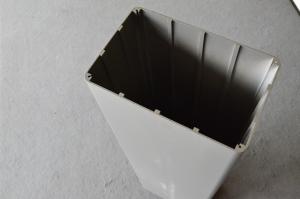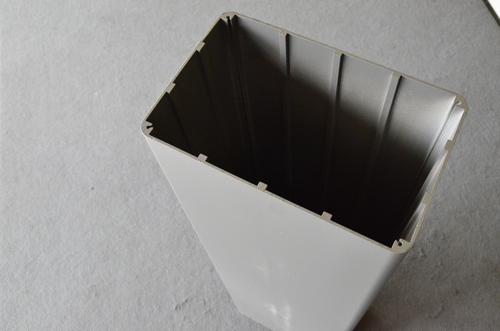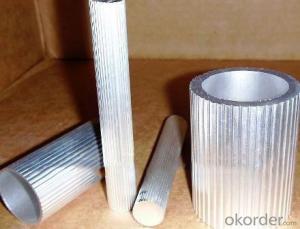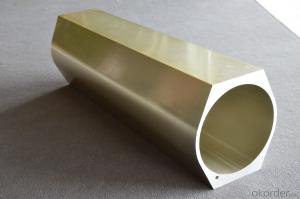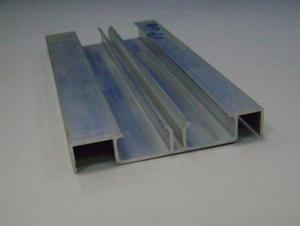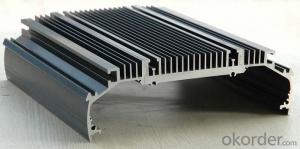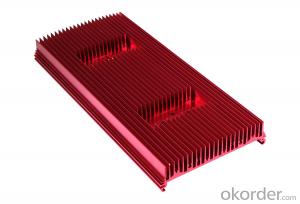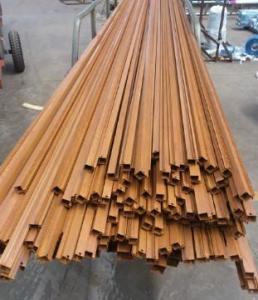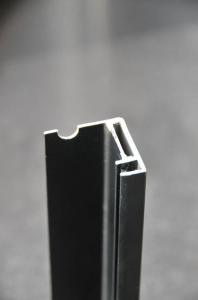Aluminum Extrusion Tube Profiles - Aluminum Sections 04
- Loading Port:
- China Main Port
- Payment Terms:
- TT OR LC
- Min Order Qty:
- -
- Supply Capability:
- -
OKorder Service Pledge
OKorder Financial Service
You Might Also Like
Industrial aluminium profile
1)Material : 6063 6061 6060 and different aluminium alloy
2)Status:T4 T5 T6 or other special status
3)Surface treatment: mill finish, anodized sliver ,anodized bronze, anodized champagne, anodized black pearl, various power coating color, electrostatic sliver, electrostatic champagne, electrostatic golden, electrostatic titanium , machine polish sliver, machine polish bronze, wooden grain color, and Fluorocarbon spraying.
4)Annual capacity : 120000TON
5)Quality : China Nation Standard GB/T 5237 2008 (advanced class)
6)Use: can be widely using aluminium window, door, curtain wall, hand railing , normal aluminium profile, decorative and industrial aluminium profile
7)Advantage: Famous Brand reasonable&market price, soonest delivery and good after sale- service
8)Type of package:protection foam+heat contracted plastic film. / wooden packing / Metal pallet or depand on clientspecial requirement.
9)Payment term:T/T:30% of total value as deposite should paid by T/T within 3 days when confirmation ,and the remaining sum should be paid by T/T before delivery.L/C: 100% at sight
10)Delivery Day: 15-30days
11)Honor : CHINA FAMOUS TRADEMARK, CHINA TOP BRAND, ISO9001-2000, CHINA SQUARE&ROUND COMMITTEE DNV
- Q: You know, aluminum radiator, why should aluminum do?
- The biggest difference of aluminum radiator is that it has good corrosion resistance. Is due to the use of aluminum, it has the characteristics of corrosion resistance, because after aluminum in contact with oxygen, the aluminum surface to form a layer of oxide film, this layer of film to corrosion effect on the corrosion of an object. So, it's very good corrosion resistance.
- Q: What are the standards and regulations that control the use of aluminum profiles in construction?
- <p>Yes, there are several standards and regulations that govern the use of aluminum profiles in construction. These include international standards such as ISO 7039 and ISO 8039, which specify requirements for aluminum alloy extruded profiles. In the United States, the American Architectural Manufacturers Association (AAMA) provides guidelines, and the Aluminum Association sets standards for aluminum products. European standards like EN 755 and EN 12206 cover aluminum extrusions for general purposes and structural applications. Compliance with these standards ensures the safety, durability, and performance of aluminum profiles in construction projects.</p>
- Q: Can aluminum profiles be used in the production of laboratory equipment?
- Laboratory equipment manufacturing can utilize aluminum profiles effectively. Aluminum, being a versatile material, finds application in multiple industries, including the production of laboratory equipment. Aluminum profiles provide numerous benefits in this regard. To begin with, aluminum possesses a combination of lightweight and strength, making it an ideal choice for constructing portable or frequently movable equipment within laboratories. Its lightweight nature reduces the strain on laboratory personnel while handling and transporting the equipment. Moreover, aluminum profiles offer easy shaping and molding capabilities, enabling the customization of laboratory equipment to meet specific requirements. This design flexibility allows for the creation of equipment with complex shapes and structures, ensuring optimal functionality and efficiency. In addition, aluminum exhibits excellent corrosion resistance, a crucial property in laboratory settings where exposure to chemicals and liquids is common. This corrosion resistance extends the lifespan of the equipment and maintains its good condition even after prolonged use. Furthermore, aluminum profiles can be anodized or coated to provide additional protection against wear, scratches, and other forms of damage. This enhances the durability and facilitates easier cleaning, ensuring the maintenance of required hygiene standards in laboratories. Lastly, aluminum possesses high conductivity, making it suitable for applications that require heat transfer or electrical conductivity. This property proves advantageous for laboratory equipment, such as heating plates, heat sinks, or electrical circuit components. In conclusion, aluminum profiles are indeed suitable for the production of laboratory equipment. Their lightweight, malleable, corrosion-resistant, and conductive properties make them an excellent choice for manufacturing various types of laboratory equipment, guaranteeing durability, functionality, and ease of use.
- Q: What are the different bending and forming options for aluminum profiles?
- Aluminum profiles offer various options for bending and forming, each with its own benefits and applications. Some commonly used methods are as follows: 1. Cold bending: This widely employed technique involves bending the aluminum profile using external force, without the need for heat. Cold bending can be performed manually or with machinery like press brakes or rollers. It is suitable for creating simple shapes and can be cost-effective for low volume production. 2. Heat bending: By heating the aluminum profile to a specific temperature, it becomes more malleable and easier to bend. Heat bending is often utilized for complex or precise shapes that cannot be achieved through cold bending. Skilled operators and specialized equipment, like heating lamps or furnaces, are necessary to ensure accurate results. 3. Roll forming: This process gradually shapes the aluminum profile into the desired form by passing it through a series of rollers. Roll forming is ideal for creating continuous shapes or long lengths of profiles with consistent dimensions. It finds common applications in industries such as construction, automotive, and furniture manufacturing. 4. Stretch forming: In this method, the aluminum profile is clamped at its edges and stretched over a form or mold. Stretch forming allows for the creation of complex curves and contours, making it suitable for applications that require intricate designs or unique shapes. Aerospace, architectural, and automotive industries often use stretch forming. 5. Hydroforming: Hydroforming utilizes pressurized fluid to shape the aluminum profile into a mold. The fluid pressure forces the metal to conform to the shape of the mold, resulting in precise and high-quality formed parts. Hydroforming is particularly advantageous for creating lightweight and structurally efficient components, making it popular in the automotive and aerospace industries. These bending and forming options offer a wide range of possibilities for shaping aluminum profiles according to specific design requirements. The choice of method depends on factors such as the complexity of the desired shape, production volume, cost considerations, and the specific industry application.
- Q: How do aluminum profiles perform in terms of thermal conductivity?
- The excellent thermal conductivity of aluminum profiles is well-known. It pertains to a material's capacity to transmit heat. Aluminum possesses a notable value of thermal conductivity, enabling efficient heat transfer from one point to another. This characteristic renders aluminum profiles extremely appropriate for applications necessitating heat dissipation or transfer, such as in the fabrication of heat sinks, radiators, or electrical components. Moreover, the high thermal conductivity of aluminum profiles facilitates quicker and more effective cooling, thus making them ideal for thermal management applications.
- Q: Are aluminum profiles durable?
- Indeed, aluminum profiles possess remarkable durability. Renowned for its exceptional strength-to-weight ratio, aluminum emerges as an optimal selection for numerous applications wherein durability assumes utmost importance. Primarily, aluminum profiles exhibit resistance against corrosion, thereby enabling them to endure exposure to harsh environmental conditions without undergoing deterioration. Moreover, aluminum profiles boast exceptional structural integrity, enabling them to withstand heavy loads and impacts without succumbing to bending or breaking. Consequently, they emerge as highly dependable and enduring, rendering them a favored choice across industries including construction, automotive, aerospace, and numerous others.
- Q: This question asks for a method to calculate the quantity of aluminum profiles required for a construction project.
- <p>To calculate the amount of aluminum profiles needed for your building project, first, measure the dimensions of the area where the profiles will be used. Determine the length and width of each profile required. Multiply these dimensions by the number of profiles needed for each section of the project. Add up the totals for all sections to get the overall quantity. Consider the type of profile and its application, as this will affect the quantity and specification. Factor in a small percentage for waste and cutting errors. For complex projects, consult with an engineer or use specialized software to ensure accuracy.</p>
- Q: What are the different grades of aluminum used in profiles?
- Profiles commonly use various grades of aluminum, depending on desired characteristics and intended applications. Some commonly used grades include: 1. 6061-T6: This grade, widely utilized and versatile, offers excellent strength, corrosion resistance, and machinability. It suits structural components, frames, and automotive parts. 2. 6063-T5: Renowned for its excellent extrudability, this grade is popular in architectural applications like window and door frames. It provides good corrosion resistance and is easily surface-treated or anodized. 3. 6082-T6: Similar to 6061-T6 in strength and corrosion resistance, this grade is often preferred for applications requiring higher weldability. It finds use in the transportation industry, manufacturing truck and trailer components. 4. 7075-T6: Acknowledged for its exceptional strength and high stress resistance, this grade is common in aerospace applications, including aircraft structures and missile components, where strength and lightweight properties are crucial. 5. 3003-H14: This grade is primarily chosen for its outstanding formability and corrosion resistance. It is often used for decorative applications like trim or architectural accents. These examples highlight the range of aluminum grades used in profiles, each offering unique properties and advantages across various industries. Selecting the appropriate grade is vital to meet specific requirements and performance expectations when manufacturing profiles.
- Q: Can aluminum profiles be customized according to specific requirements?
- Yes, aluminum profiles can be customized according to specific requirements. Aluminum is a highly versatile material that can be easily molded, cut, and shaped to meet various design specifications. It can be customized in terms of dimensions, shape, thickness, and surface finish. Additionally, aluminum profiles can be further customized through processes like drilling, bending, welding, and powder coating to achieve desired functionality and aesthetic appeal. This ability to customize aluminum profiles makes them suitable for a wide range of applications in industries such as construction, automotive, aerospace, and electronics.
- Q: What are the different welding options available for aluminum profiles?
- There are several welding options available for aluminum profiles, each with its own advantages and considerations. The most common welding methods for aluminum profiles include: 1. Tungsten Inert Gas (TIG) Welding: TIG welding is one of the most widely used methods for aluminum. It uses a non-consumable tungsten electrode to produce the weld, while an inert gas, such as argon, protects the weld area from atmospheric contamination. TIG welding offers excellent control over the heat input, resulting in high-quality, precise welds. It is suitable for thin aluminum profiles and provides a clean appearance, but it can be time-consuming and requires skilled operators. 2. Metal Inert Gas (MIG) Welding: MIG welding, also known as Gas Metal Arc Welding (GMAW), is another popular method for aluminum profiles. It uses a consumable wire electrode that continuously feeds into the weld pool, while an inert gas shield protects the weld area. MIG welding is faster than TIG welding and is suitable for both thin and thick aluminum profiles. However, it may produce more spatter and requires proper preparation and shielding gas selection. 3. Friction Stir Welding (FSW): Friction stir welding is a solid-state joining process that uses a rotating tool to generate heat and mechanically stir the aluminum profiles together. FSW is particularly suitable for thick aluminum profiles and offers high joint strength, excellent fatigue resistance, and minimal distortion. However, it requires specialized equipment and may not be suitable for all profile shapes. 4. Laser Beam Welding (LBW): Laser beam welding uses a highly concentrated laser beam to melt and join aluminum profiles. It provides a narrow and deep weld with minimal heat input, resulting in low distortion and high welding speeds. LBW is suitable for both thin and thick profiles, but it requires expensive equipment and skilled operators. 5. Resistance Spot Welding (RSW): Resistance spot welding uses electrical current and pressure to create welds by melting and joining aluminum profiles at specific points. RSW is commonly used for thin aluminum profiles and offers high productivity and repeatability. However, it requires access to both sides of the profiles and may leave visible marks on the surface. It is important to consider the specific requirements of your aluminum profile welding project, such as profile thickness, joint type, appearance, and production volume, to determine the most suitable welding method. Consulting with a welding professional or engineer can help ensure the best choice for your specific application.
Send your message to us
Aluminum Extrusion Tube Profiles - Aluminum Sections 04
- Loading Port:
- China Main Port
- Payment Terms:
- TT OR LC
- Min Order Qty:
- -
- Supply Capability:
- -
OKorder Service Pledge
OKorder Financial Service
Similar products
Hot products
Hot Searches
Related keywords
